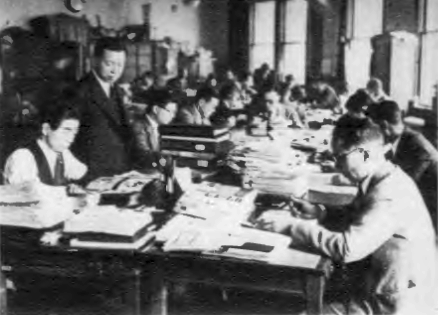Mark Scott Smith's Blog: Enemy in the Mirror, page 114
May 5, 2014
FDR Fireside Chat – April 1942

FDR 1942; Wikimedia Commons
“It is nearly five months since we were attacked at Pearl Harbor. …American warships are now in combat in the North and South Atlantic, in the Arctic, in the Mediterranean, in the Indian Ocean, and in the North and South Pacific. American troops have taken stations in South America, Greenland, Iceland, the British Isles, the Near East, the Middle East and the Far East, the continent of Australia, and many islands of the Pacific. American war planes, manned by Americans, are flying in actual combat over all the continents and all the oceans.
…Our soldiers and sailors are members of well-disciplined units. But they are still and forever individuals—free individuals. They are farmers, and workers, businessmen, professional men, artists, clerks.
They are the United States of America.
That is why they fight.
We too are the United States of America.
That is why we must work and sacrifice.
It is for them. It is for us. It is for victory.”
Franklin D. Roosevelt: Fireside Chat - April 28, 1942
The post FDR Fireside Chat – April 1942 appeared first on Enemy in the Mirror.
May 2, 2014
Japanese Hell Ships – 1942

Tango Maru, Wikimedia Commons
In May 1942 Japanese “Hell Ships” began transferring Allied prisoners of war to Japan. With conditions not unlike those of the infamous Bataan death march, prisoners were often packed into stuffy cargo holds with little food or water. Many POWs died of thirst, dehydration, asphyxiation and starvation on the long the trip to Japan that might take weeks.
Unfortunately, >20,000 POWs also died at sea when the unmarked Hell Ships were attacked by Allied submarines and airplanes. Although Allied commanders often knew of the presence of POWs on these ships through radio interception and code breaking, attacks were not aborted. Some critics maintain that the interdiction of critical supplies for Japan’s war machine was the highest priority at the time – perhaps higher than sparing POW lives.
The post Japanese Hell Ships – 1942 appeared first on Enemy in the Mirror.
April 30, 2014
Goebbels on Food Rationing – Das Reich March, 1942

Joseph Goebbels and family; Wikimedia Commons
Reich Minister of Propaganda Joseph Goebbels wrote a weekly column in the newspaper Das Reich. In March 1942, he alerted the German public to a pending cut in food rationing. Goebbels stated that food shortage resulted from two years of bad harvests, military food requirements and the influx of many foreign workers.
With food rationing already very tight, it was reported that the general public was shocked, but in favor of harsh actions against the black market. On the other hand, many were apparently not convinced of Goebbels’ claims that things were as bad or worse in England.
The post Goebbels on Food Rationing – Das Reich March, 1942 appeared first on Enemy in the Mirror.
April 28, 2014
▶”A Letter From Bataan” – 1944
In this film, made as a “Victory short” by Paramount Pictures in collaboration with the U.S. Office of War Information, a mother receives a letter from a soldier who was killed in action at Bataan. As the mother reads the letter aloud on the front porch to the rest of family, the ghost of the dead soldier elaborates, commenting on the sacrifices that need to made to provide essential materials and food for soldiers overseas.
The post ▶”A Letter From Bataan” – 1944 appeared first on Enemy in the Mirror.
April 25, 2014
Bataan Death March – April 1942

Bataan Death March; Wikimedia Commons
On April 9, 1942, after a three-month battle, more than 11,000 American and 66,000 Filipino soldiers surrendered to the Japanese on the Bataan peninsula in central Luzon, Philippines. Starving and stricken with malaria, beriberi or dysentery, they never saw the reinforcements that their departing General MacArthur had assured them were on the way. The Japanese military, seeking to move American and Filipino soldiers out of Bataan quickly so they could launch immediate attacks on Corregidor, began an 80-mile forced march of the prisoners.
The Japanese were unprepared for the number of prisoners captured, and had no organized plan to give them food or water. Guarded by Japanese soldiers who despised soldiers who chose to surrender instead of fighting to death, the POWs on the march suffered horrendous abuse, outright murder and a high rate of death from thirst, starvation and exhaustion. The exact number of deaths has never been established, but a conservative estimate is approximately 6,000 Filipinos and 650 Americans.
In response to American outrage, Japanese authorities at the time claimed the humanely-treated prisoners died because American commanders didn’t surrender until their men were on the verge of death. In 1945, General Masaharu Homma , who maintained ignorance of the high death toll on the march until two months after the event, was found guilty of war crimes and executed in 1946.
The post Bataan Death March – April 1942 appeared first on Enemy in the Mirror.
April 23, 2014
Volksgerichtshof – People’s Court

Volksgerichtshof; Wikimedia Commons
The German Volksgerichtshof (People’s Court) was established in 1934 by Chancellor Adolf Hitler to function outside the constitutional legal framework. The Volksgerichtshof had jurisdiction over a large number of political offenses, including black marketing, work slowdowns, defeatism and treason against the Third Reich. These crimes, viewed as undermining military capacity were punished severely, frequently by execution.
The post Volksgerichtshof – People’s Court appeared first on Enemy in the Mirror.
April 21, 2014
US Q-Ship vs U-Boat – March 1942

U-123; Wikimedia Commons
USS Atik was a heavily armed merchant ship with concealed weaponry (a Q ship) that was designed to lure submarines into making surface attacks. The Atik had a crew of 141 men and an armament of four 100 mm naval guns, eight machine guns and six K-guns (depth charge projectors).
At 7:30 PM on March 27, 1942 the U-123 , under the command of Kapitänleutnant Reinhard Hardegen , firing from a surfaced position, struck the Atik with a torpedo on the port side. On fire, and starting to list, the Atik’s captain, Lieutenant Commander Harry Lynnwood, lured the U-boat within range of his guns was by ordering a lifeboat lowered on the starboard side. When U-123 maneuvered alongside, the Atik opened fire with all of her guns and depth charges. The bridge of the U-123 was slightly damaged and one German sailor was mortally wounded.
Hardegen ordered his deck gun into action and fled out of Atik‘s range before diving. At 9:29 pm the submerged U-123 struck the Atik with another torpedo. At 10:27 PM, as the Atik’s crew began evacuating their ship, the U-123 surfaced again. At 10:50 pm the Atik exploded and then a gale blew in, killing all of the 141 American sailors.
The post US Q-Ship vs U-Boat – March 1942 appeared first on Enemy in the Mirror.
April 18, 2014
Censorship in Wartime Japan

Government censors 1938; Wikimedia Commons
Since feudal times, the Empire of Japan had a long tradition of censorship of political discourse. In 1936, the Information and Propaganda Committee issued all official press statements and worked with the Publications Monitoring Department to censor all types of media. The committee issued detailed guidelines to publishers and made (mandatory) suggestions. Any book, magazine, news article or photograph “unfavorable” to the Imperial Army or portraying atrocity (e.g., Tatsuzō Ishikawa’s account of the Nanjing massacre) was prohibited. Writers deemed to promote dissidence were frequently imprisoned.
A 1941 revision of the National Mobilization Law eliminated freedom of the press completely. All mail was now subject to scrutiny. In February 1942, all newspapers were ordered to merge, or to cease publication. The Japan Publishers Association agreed to screen all publication drafts before final submission to the official government censors. As the Pacific War situation deteriorated, the government assumed control of all paper supplies, and permitted use only for official policy issues. In 1944, only 34 magazines were left in publication. In 1945, only one newspaper was permitted per prefecture.
read more: Censorship in the Empire of Japan – Wikipedia, the free encyclopedia.
The post Censorship in Wartime Japan appeared first on Enemy in the Mirror.
April 16, 2014
Doolittle Raid on Tokyo – April 1942
In April 1942, sixteen twin-engine B-25 Mitchell bombers, launched from the aircraft carrier Hornet, attacked Japan. The daring raid, led by Lieutenant Colonel James H. Doolittle, designed to boost American morale after the Pearl Harbor attack, also demonstrated the feasibility of launching bombers from an aircraft carrier.
Despite the enthusiastic report in this video, the raid actually caused little material damage, with strikes only to non-military targets or complete misses. It was, however, a propaganda victory and cast doubt in the mind’s of Japanese citizens regarding the ability of their military to defend their home islands. After the attack, Japan also withdrew its aircraft carriers from the Indian Ocean to protect the homeland.
Fifteen of the B-25s reached China; one landed in the Soviet Union. All but three of the crew survived. Eight were captured by the Japanese Army in China and three were executed. The crew of the B-25 that landed at Vladivostok was interned for more than a year in the Soviet Union. Fourteen crews, except for one crewman, returned either to the United States or to American forces.
The post Doolittle Raid on Tokyo – April 1942 appeared first on Enemy in the Mirror.
April 14, 2014
Holocaust – Occupied France

1939-1945 map of all death camps, most major concentration camps, labor camps, prison camps, ghettos, major deportation routes and major massacre sites; Wikimedia Commons
When Nazi Germany occupied the country in June 1940, there were ~ 350,000 Jews living in France, ~ 200,000, resided in and around Paris.
Several ordinances published by the occupation force during 1940-41 defined who was a Jew, what business activities they were allowed, confiscated their radios & bicycles, disconnected their telephones, set curfews just for them, closed public places, theaters and certain shops to them, assigned them the last Metro coach, and banned Jewish music and art.
The first large scale incarceration of Jews took place in May 1941 when 4,000 foreign Jews were sent to concentration camps in France. In December 1941, Parisian Jewish community leaders, including doctors, academics, scientists and writers, were rounded up. In May 1942, all Jews were ordered to wear the yellow star. Beginning in 1942, Germans deported 75,500 – 76,000 (mostly foreign-born) Jews from France to death camps.
From the start, the Vichy government openly collaborated with the Nazi occupiers to identify Jews for deportation and transportation to the death camps. At the same time, many non-Jewish French citizens risked their lives to save Jews from the Holocaust.
The post Holocaust – Occupied France appeared first on Enemy in the Mirror.
Enemy in the Mirror
I began by posting events around the turn This website www.enemyinmirror.com explores the consciousness, diplomacy, emotion, prejudice and psychology of 20th Century America and her enemies in wartime.
I began by posting events around the turn of the 20th century as I was researching my first novel about the Pacific War. I continued through WWII for my second novel about the Battle of the Atlantic. Now I am beginning to look at the Cold War as I gather information for my next novel about the Korean War. ...more
- Mark Scott Smith's profile
- 7 followers



